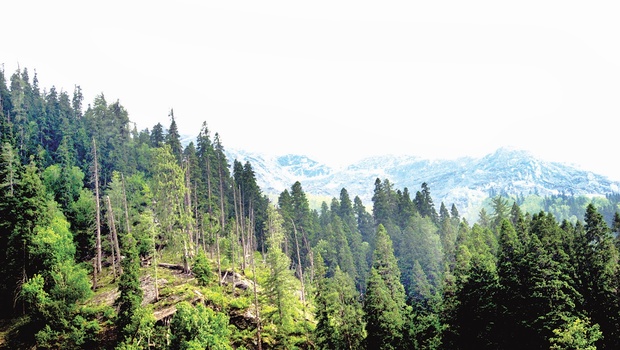The idyllic village of Tosh, located at the edge of the Parvati valley near Kasol, Himachal Pradesh, has only a few thousand inhabitants. The village is no different from hundreds of others scattered right across the great Himalayan belt passing through a major part of North and North-East India. One of the many obscure villages that exist in Himachal Pradesh, Tosh however is different since it attracts a large number of foreign tourists. A majority of these foreigners are Israelis. The village is also becoming a favourite destination of backpackers and hippies. The reason for this is quite simple. Tosh offers tourists a beautiful view of the surrounding hills, an experience of living in a rustic hamlet without fancy hotels.
It has cheap food, nominally priced rooms for a night’s stay, easy access to hash (which is the primary reason for attracting a certain section of tourists) and a passage to Kheerganga ( located around 12 kms above Tosh). Kheerganga is of particular significance to worshippers of Shiva. According to mythological stories, Shiva’s elder son, Karthikeyan, is believed to have meditated here for many years.
Kheerganga is also home to a natural hot water spring. The hot water spring is a major attraction for tourists. Many trekkers even choose to trek up to Kheerganga just for the pleasure of travelling through the great mountains and enjoy the diverse scenic beauty the journey offers. The trek offers a view of snow capped peaks, waterfalls, tall, sundappled trees, rocks, cold breeze brushing past as the sun begins to fade away and a never ending trail covering a distance of 12 – 13 kms through the mountains.
Technically, the Kheerganga trek covers a distance of 15 kms if one begins to walk from Tosh village. Some people prefer to cut down the distance to 12 kms by choosing to take a ride till Bharsheni, the last point accessible to vehicles.
What is unique about the Kheerganga trek is that it is not just a tough, steep and upward climb throughout. Parts of the trek are through large meadows and walkable terrain and some parts are reasonably steep and at times slippery. One misstep in some places and a person could go freefalling through sharp bushes and steep slopes.
The good news is that with a bit of extra care in the tricky places, a novice too can negotiate the risky spots without much difficulty. There are around three major resting- points in the trek where tourists can take a break and get something to drink and eat. It goes without saying that travellers should carry a bottle of water and some eatables during the trek.
Some brave folks even choose to carry their own bags instead of availing the services of a porter. A majority of the foreigners as well as enthusiastic backpackers and regular trekkers choose to not opt for porter services.
For those who are unsure and not too comfortable with long treks, it is advisable to take a porter along to carry the luggage.
An extra pair of clothes, some warm clothing and a torch (extremely important) should suffice.
The trek can take anywhere between five to six hours or even longer but the return journey is shorter by around 30 per cent of the uphill time.
Some people even plan to undertake the return journey on the same day. It is however advisable to stay back for the night and begin the descent the next day.
This will not only avoid over-exertion, but also give adequate time to enjoy the lovely view that the place offers.
The hot water spring too functions only till 8 pm in the evening. Those who miss out on having a bath on the first day, can do so on the next day before beginning the descent.
A unique feature of Kheerganga is the near absence of lights and electricity. The entire place gets engulfed in darkness after sunset. The cafes provide food till around 10-10:30 pm at night. Tents are put up for visitors for sleeping at night.
There also are a few wooden shacks and dormitories to stay in. These shacks and common rooms are completely different from a regular stay at any hotel and offer a unique experience. Needless to say, it gets quite cold at night even in summer.
Dawn offers snapshots of lush green hills and snow-capped peaks being kissed by the clouds. The beauty of the place lies in its quietness, stillness and remoteness. One feels as if time has stopped for good.
The weather in Kheerganga changes quite drastically during the monsoon season. One moment it might be bright and shining. In a few minutes, however, it might start raining and temperatures can drop significantly.
Extra warm clothes are usually required only after evening. Food is available at the cafes at reasonable rates. The locals who run the cafes are friendly and amiable. It is however advisable to carry your own booze and cigarettes.
Those who wish to stay away from their mobile phones, routine city life for a few days with some amount of physical activity may find Kheerganga to be an ideal destination.
The overall trek is of moderate difficulty and doable even for first time trekkers with reasonably decent physical condition and health. The Kheerganga trek can be a good stepping stone for undertaking other more difficult treks through the great Himalayan ranges.
Pranav is a Mumbai based sustainability analyst. Besides earning his daily bread with a typical 9-5 job, he likes to travel and exercise. He also is an avid reader, passionate writer and a foodie. He likes writing on topics related to climate change, sports, movies, politics and travel. He has his own blog –www.pranav84blog.wordpress.com which he tries to update once in a while.






